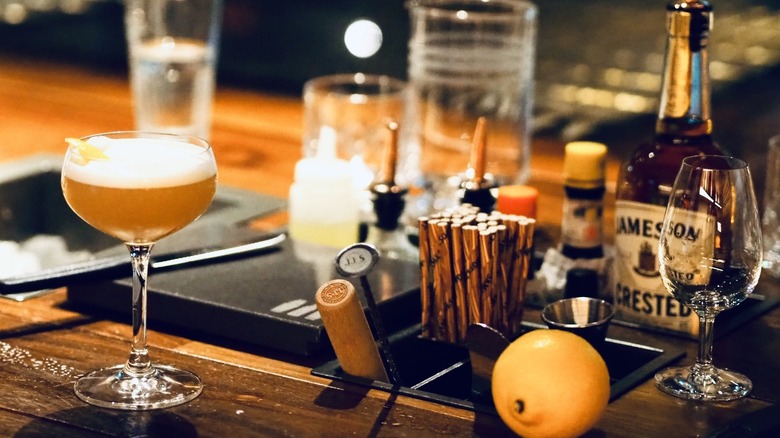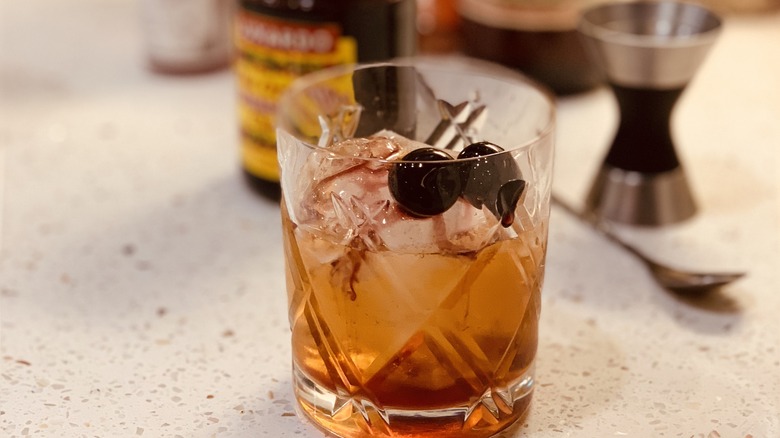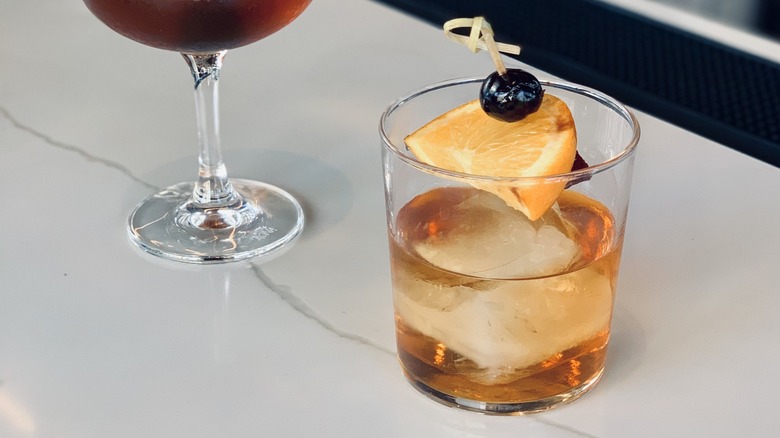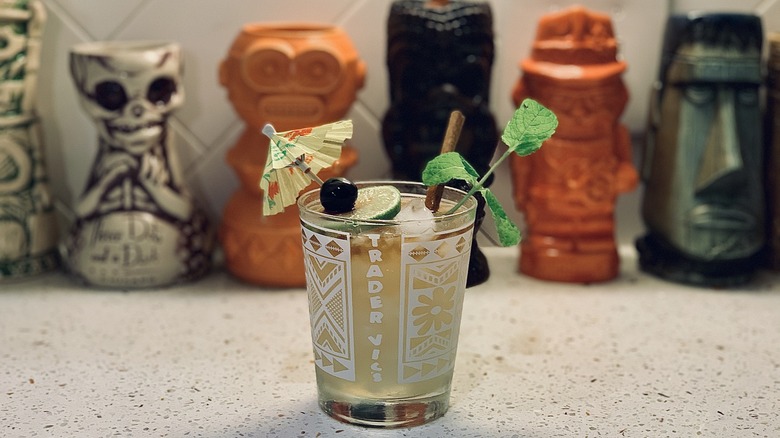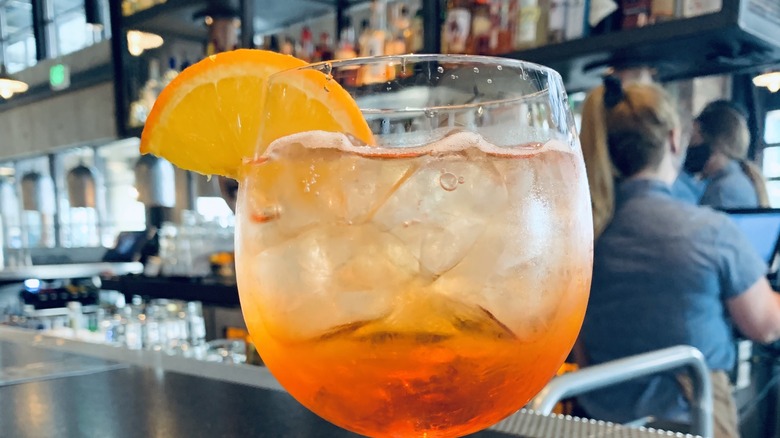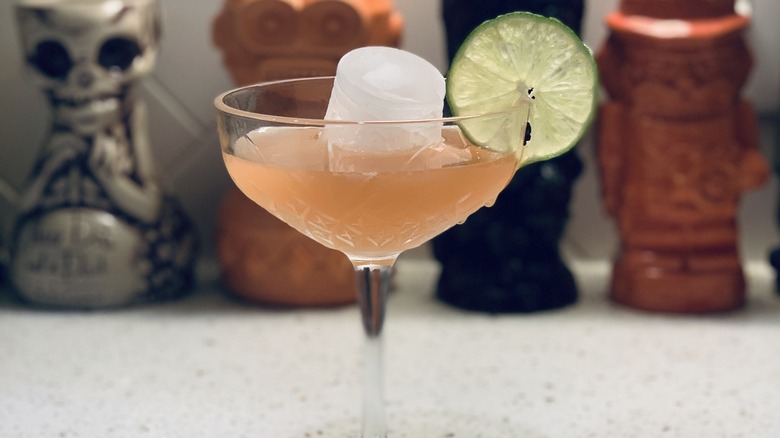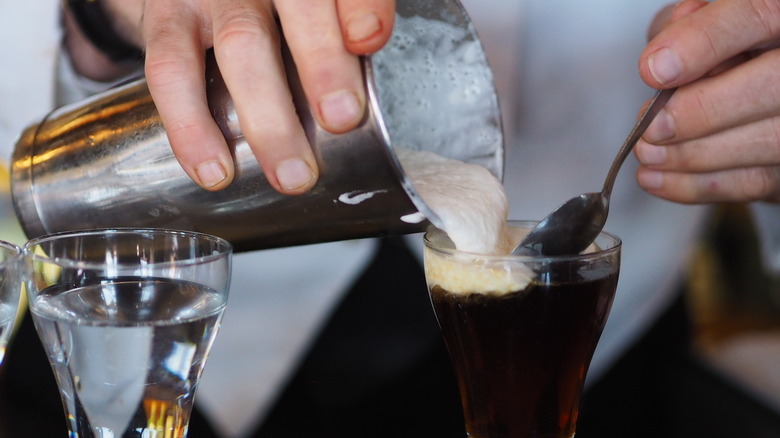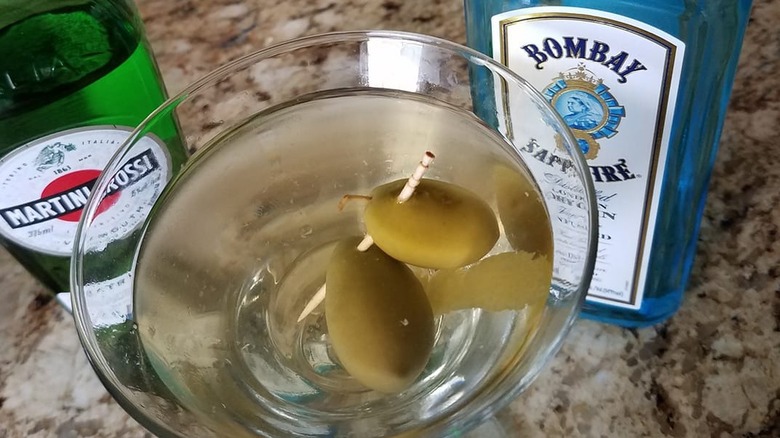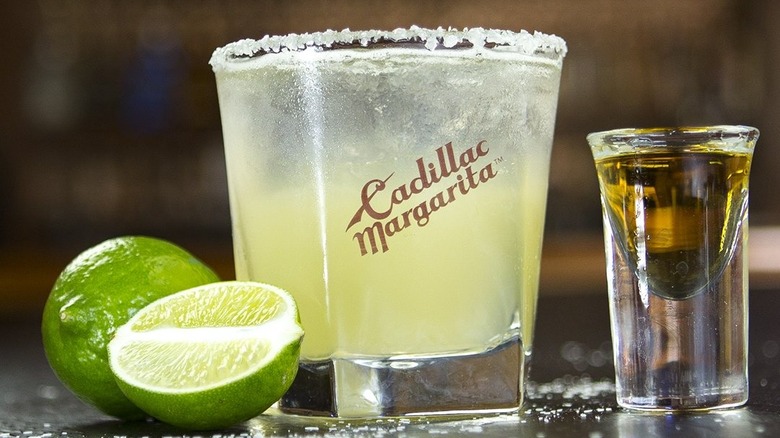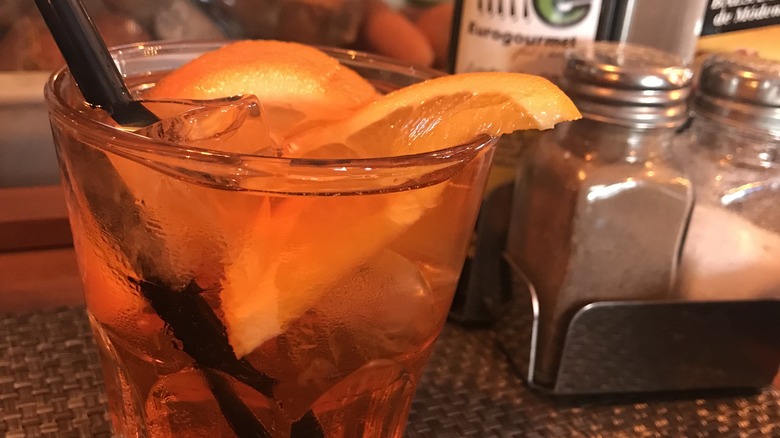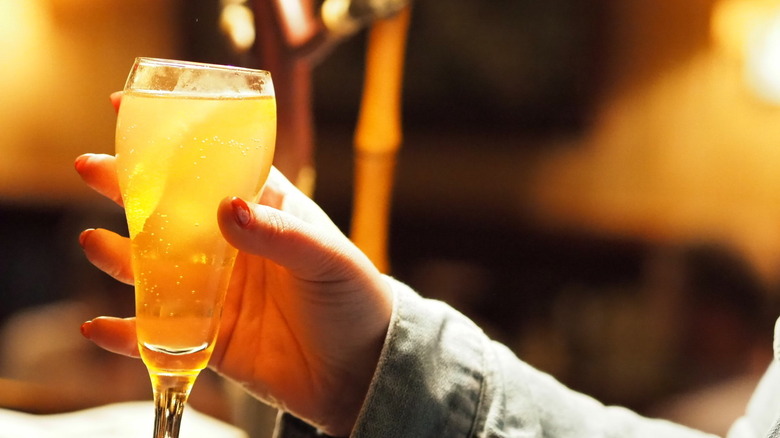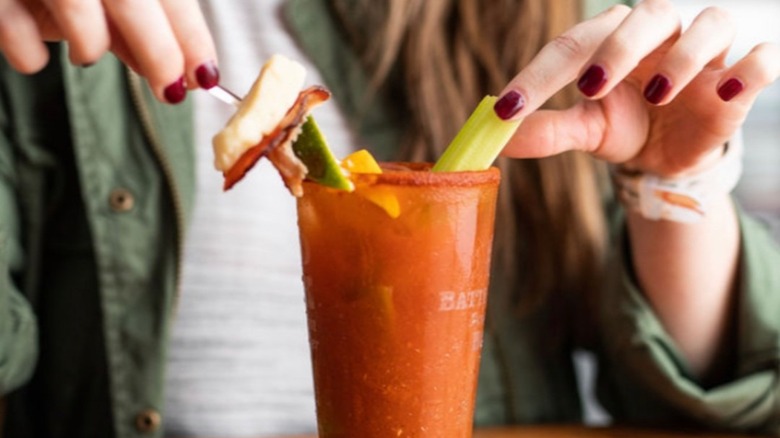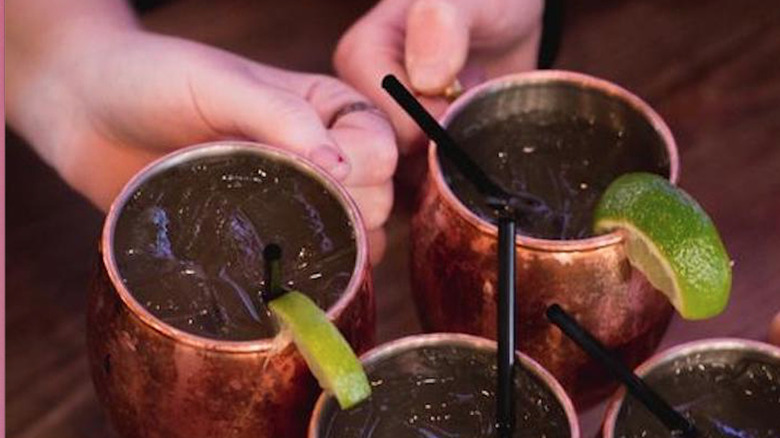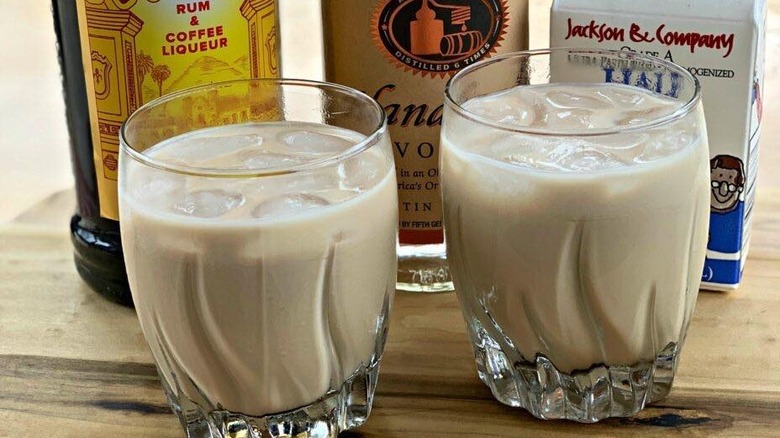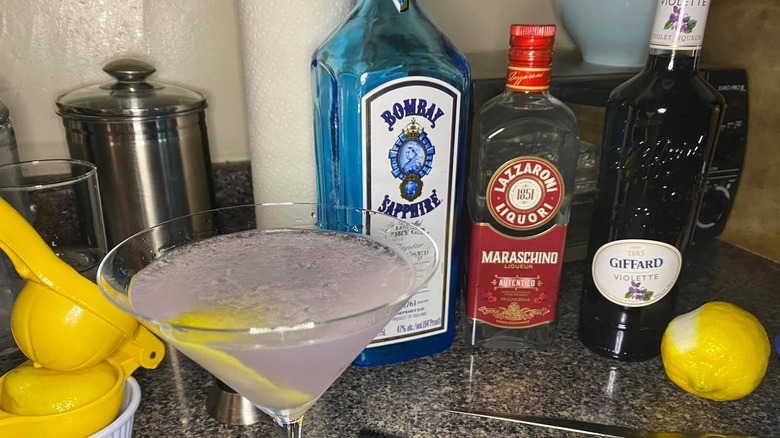Essential Drinks Every Home Bartender Needs In Their Bar
The cocktail business is no joke. There's a reason you're paying a premium price, sometimes of upwards of $20 for a drink — that's because crafting a cocktail is truly an art. It not only takes a well-skilled individual with a passion for the saucy stuff but a perfectly balanced cocktail requires quality and fresh ingredients as well as the right liquor. With just one ingredient not playing in perfect harmony, the entire drink will face the consequences.
While there are quite a few cocktails you should probably avoid making at home because of their complexities and skill level required— like a proper tiki cocktail that requires fresh cinnamon syrup and allspice dram — there are plenty of cocktails you can add to your arsenal making a solid (and impressive) list for any amateur at-home bartender.
Maybe you can't make it to a Death & Co., or you're looking to seriously impress your guests at your next dinner party, so please join us on this boozy journey as we learn more about your favorite cocktails, their fascinating origins, and how to mix them up yourself at home.
Here are our essential drinks every home bartender needs in their bar.
Manhattan
It really doesn't get any more classic, or simple, than a Manhattan. It's a straight shooter of a cocktail that needs little introduction. With an inherently short list of ingredients, we've seen countless versions on menus all across the globe. While it only requires rye or bourbon (The debate is still out there), Italian vermouth, and Angostura bitters, this one Is not for the faint of heart. A perfect Manhattan is quite boozy.
With traces to Manhattan, New York, the history of the Manhattan may perhaps be forever left in the past, with countless theories and rumors. Its first known written proof of the cocktail is a recipe dating back to 1891. Regardless of its origins, no one can debate that it is one of the most popular and beloved cocktails in the world.
There's a few tips for creating the perfect one at home. Never shake the drink when preparing, instead stir to prevent any diluting or foaming of this booze-forward creation. With a chilled cocktail glass ready at your wayside, simply stir together in a mixing glass with crushed ice 2 ounces of American rye or bourbon, 1 ounce of Italian vermouth for a bit of sweetness, and 2 dashes of Angostura bitters to give it that bit of aromatic spice. You'll then strain it into your chilled glass and garnish it with a lemon twist or cocktail cherries (we're quite a fan of Luxardo cherries).
Old Fashioned
The Old-Fashioned is another vintage cocktail that has stood the test of time despite its seemingly simple in nature demeanor. The classic Old-Fashioned, just like the Manhattan, is booze-forward and features just three ingredients. Whiskey, or less commonly Brandy, comes together with sugar and bitters creating the perfect sip of sophistication. With old-fashioned programs introduced in countless cocktail bars and fun interpretations, like a smoked old-fashioned, the original creation has origins that date back to 1880. We likely have Louisville, Kentucky bartender James E. Pepper, of the private club The Pendennis Club, to thank.
In a traditional presentation, a rocks glass is filled with a sugar cube, a few dashes of bitters, and a teaspoon of water. After dissolving this solution, you'll add a large ice cube to the glass, just one cube, and then top with bourbon and gently stir. To ensure the drink is properly balanced and the sugar is dissolved, you may have to stir upwards of 20 times. For a hint of citrus, after squeezing your thick orange peel strip over the glass, give it a little rub around the rim before dropping it in.
1944 Trader Vic Mai Tai
You may feel inclined to write this one off as a fruit concoction topped best served on a beach, but you'd be dead wrong. A real Mai Tai is a boozy, rum filled glass of delight with a colorful history. The Mai Tai was created in 1944 by Trader Vic, real name Victor J. Bergeron aka the godfather of tiki drink. Donn The Beachcomber, his arch-rival, would refute this and claim the drink was his. Regardless, the Trader Vic Mai Tai featured 17-year-old J. Wray and Nephew Jamaican Rum. It became so popular, thanks to American's sheer fascination with escapism culture, it's partly accredited for a rum shortage.
So, what happened to this beloved cocktail along the way? The confusion lies when Trader Vic was asked to dumb it down to appeal to the tourists coming into Hawaii. The real deal uses 2 ounces of blended rum, ¾ ounce of fresh (non-negotiable) lime juice, ¼ ounce orgeat, ¼ ounce rich demerara simple syrup, and ½ ounce of orange curacao.
All ingredients are shaken with crushed ice and then poured, ice and all into a double old-fashioned glass. Don't be turned off by these seemingly complicated ingredients as demerara simple syrup is actually simple to make at home. A mint sprig and half of a spent lime shell will complete the cocktail as the garnishes. Trader Vic hated umbrellas, but if you feel so inclined, go ahead and use them. Tiki is what you make it after all!
Aperol Spritz
If you're a fan of kicking back a few during happy hour, you've probably heard of Aperitivo hour. The Italian tradition of relaxing before dinner with a low-alcohol, refreshing beverage dates back to the early 20th century but has since become a new favorite American pastime. It's not solely a means to rev up the appetite before dinner, but as a way to connect with friends and unwind after the day. Drinks consumed are typically using an Italian bitter or vermouth as a base with the drink of choice for a classic Apertivo hour being an Aperol Spritz.
The Aperol Spritz was invented in the 1950s as a derivative of the original spritz, the Venetian Spritz which used white wine and soda. Aperol is an Italian bitter liqueur with just a hint of sweetness and only 11% alcohol by volume that dates back to 1919. Aperol didn't make its way globally until it saw worldwide distribution by Campari in the early 2000s. To make an Aperol Spritz, simply fill a wine glass up with ice and then pour Prosecco up filling about half of the glass. The remaining glass is filled with equal parts Aperol and soda water. A simple slice of orange is all that garnishes this cocktail.
Hemingway Daiquiri
Ah, Ernest Hemingway. Acclaimed author. Well-known drunk. It's not really a surprise that there would be a cocktail named after him with a reputation like that. After all, the guy could drink. The fabled story of the cocktail known as the Hemingway Daiquiri takes us to 1930s Havana, Cuba. While he was likely inebriated at the El Floridita bar, Hemingway spotted the bartender making a classic daiquiri, and obviously grabbed it to take a sip. Much to his dismay, it was not nearly boozy enough (for him), and so the Hemingway Daiquiri was born.
The Hemingway Daiquiri has been adapted and tweaked over the years, most likely due to the resurgence of the craft cocktail experience. It can be found on cocktail menus around the world and offers a welcomed boozy-meets-sweet-meets-tart. It's incredibly easy to make at your home bar and a wonderful chance to flaunt your knowledge of the beverage's interesting backstory. In a cocktail shaker with ice, combine 2 ounces light rum, 3/4 ounce of fresh lime juice, 1/2 ounce of fresh grapefruit juice, 1 teaspoon of Maraschino liqueur, and 1 teaspoon of sugar. After a good shaking, stream it into a cocktail glass and garnish it with a lime. To really nail this one, it's imperative that your juices be freshly squeezed and you may want to be a little soberer than Hemingway to nail the ratio of ingredients.
Irish Coffee
When you need a little pick-me-up, there's nothing better than a coffee to give you that welcomed jolt to fight that afternoon slump. The Irish Coffee *shocker* was created in Ireland where it remains a staple to this day thanks to the country's consumption of their favorite libation, Jameson Irish Whiskey, of course. The story of how it made its way to America may be even more fascinating than its invention. Journalist Stan Delaplane was traveling through Ireland in 1951 when he had a chance meeting with the drink.
So enamored by it, upon arrival back to San Francisco, he told his friend Jack Koeppler, owner of the Buena Vista Café all about. And so, the two set out to master it and introduce it to the American palate (via Better Living). It proved to be such a success, to this day people still line out outside the Café for a chance to snag a seat at the bar or at a table to sip on the soul-warming beverage. The trick to mastering this drink is properly frothing the heavy cream until it's thick. The Irish Coffee is served in a heated glass goblet that is filled first with 1.5 ounces of Tullamore Dew Whiskey followed by 4 ounces of hot coffee and 2 sugar cubes. After this mixture is properly mixed, the frothed heavy cream is slowly poured on top over a spoon, just like a Guinness.
Martini
Shaken or stirred, the martini remains the most iconic drink of our time and will likely always be. Whether you're a gin snob, or a vodka buff, everyone can agree a martini is absolutely essential for any at-home barkeep. The drink has maintained its same core ingredients since its invention in the late 1800s. It's certainly been bastardized to endless degrees and somehow any drink in the glass is labeled a "martini," but a true Martini finds you sipping on a base spirit with vermouth.
The earliest incarnation of the martini is thought to have been created by bartender Jerry Thomas in the 1880s who combined sloe gin with sweet vermouth. The drink was later accredited to the Knickerbocker Hotel in New York City where the martini combined dry gin with dry vermouth.
Whatever the story may be, the gin martini we all know and love can be created at home with a quality dry gin or vodka and dry vermouth. The ratio is up to the drinker's preference and the garnish is typically a standard lemon peel. At the end of the day, the martini can be interpreted to your liking, and even sees the addition of olive juice to make it "dirty," but beauty is in the eye of the beholder (and drinker).
Cadillac Margarita
There's not many things we can all agree on, but one thing is for sure: many great nights (and possibly not so great morning afters) can be attributed to tequila. While tequila dates back to 16th-century Mexico, the Margarita wasn't a thing until some 400 years later. The stories are jumbled, as they usually are after anything involving the agave spirit, but it's thought to have originated at the Turf Bar in Tijuana, Mexico (via Food & Wine). The drink shortly after migrated across the border to the land of incessant sun and humidity, Dallas, Texas, where frozen drinks quickly caught momentum.
The margarita does have one flaw (And it's a pretty big one). Far too often, the drink is created using low quality and cheap ingredients causing a drink that brings along an exorbitant amount of calories and a brutal sugar hangover the next day. This solution is the invention of the ever as popular, Cadillac Margarita, born in health-conscious California. Thanks to the introduction of premium agave tequila in the U.S. in 1989 by Patrón, the Cadillac Margarita was first introduced on the menu at Wolfgang Puck's Hollywood hotspot Spago. Top Shelf tequila comes together on the rocks with near equal parts premium brand-based orange liqueur and a squeeze of fresh lime for truly the Cadillac of Margaritas.
Negroni
We head back to Europe for another beloved cocktail: the Negroni. While considered an aperitif, this one is quite stronger than the distant cousin, the Aperol Spritz. The reason for its strength? It was actually created when French General Pascal Olivier Count de Negroni, requested his favorite drink, The Americano, to be strengthened with the use of gin in place of its usual soda water. We also have that bartender to thank for its garnish of an orange peel.
The drink packs a punch but is impressively smooth to drink. It also comes with the added foolproof bonus of being classically made with a 1-to-1 to 1 ratio of ingredients. Tasty, boozy, and easy to make ... what's not to love? Using an ice-filled mixing glass, you simply stir the gin, vermouth, and Campari until it's properly cold. It's then strained into an ice-filled glass and topped with a fresh peel of orange. Cheers!
French 75
With a storied history and influences of French, Spanish, and beyond, New Orleans is home to many incredible delicacies of the food and beverage world. We have them to thank for beignets, po-boys, and the French 75? Well, sort of ... Arnaud's French 75, located in the city's French Quarter, is now synonymous with the drink, but its origins are a bit murkier than the brightly hued thirst-quencher that happened to be named after a WWI firing field gun.
Their version uses cognac as the base spirit, whereas many of the first written recipes of the cocktail called for gin. Whether they invented it or not, they have perfected it. A French 75 is all things fizzy and fun with just the right amount of booze to get the night going. Making the beverage for yourself is simple. In an ice-filled shaker, combine 1 ½ ounce of Cognac, 1 teaspoon lemon juice, and ¼ teaspoon of simple syrup. Give it a couple of shakes before pouring it into a chilled champagne glass. You'll then fill the rest of the glass with Champagne and top it off with a twist of lemon and wait as the good times roll. If you're really looking to impress, you can use Moet & Chandon with Courvoisier VS just like Arnaud's.
Bloody Mary
The Bloody Mary is now the epitome of the American brunch. Bottomless sips abound, we've Americanized it so much you can even stumble upon many over-the-top versions topped with mini-meals, like sliders, beef jerky, and even crab legs. Its actual origins likely stem from Europe, specifically from Harry's New York Bar in Paris. It's fabled that a bartender conceived the drink there during the 1920s only to later bring it with him to New York City after Prohibition. There are also murmurs that the drink may even date back to the 1550s and Queen Mary I of England.
History lessons aside, it is one of the most customizable drinks with the base, tomato juice, and vodka, acting as the foundation for whatever your imagination holds. There are no rules. While in its most basic form people most commonly will add a squeeze of lemon juice, Tabasco sauce, and Worcestershire sauce — but this is all based on your preference. Our favorite version uses all of these additives as well as horseradish and just a dash of celery bitters. The only limit is your mind — just please don't top it with a sub – that is just barbaric.
Moscow Mule
When did Moscow Mules get so popular? The real question should be: When did they get back to being so popular? According to the New York Times, the Moscow Mule is the reason vodka ever became popular in the United States. It was invented in the early 1940s as simply a combination of vodka, lime juice, and ginger beer that was served on ice in those signature, and now widely available copper mugs. The drink first gained popularity on the West Coast thanks to the then beverage purveyor behind Smirnoff trying to hawk his vodka.
The drink is seeing a renaissance again with, according to GuestMetrics, a 60 percent menu addition increase in 2015. Of course, the popularity of this magnitude has also created variations, like using bourbon in place of vodka as a base. We prefer to stick to the classic which uses Vodka, a quality ginger beer like Fever-Tree (trust us, that makes a difference), and fresh lime juice (also very important). Also, don't dare serve us one unless it's in the copper mug.
White Russian
We have a certain 1990s blockbuster to thank for the popularity of this next one. The White Russian is a spin on the Black Russian, and no, it was not conceived in Russia, but rather Belgium. With a base of vodka (hence its title using "Russian"), this coffee-infused cocktail is the perfect way to end an evening. In its infantile stages compared to the other drinks on our list, the first written records of this cocktail in America date back to 1960s California. It was then in 1998, when the entire world caught The Dude, played by Jeff Bridges, throwing them back in "The Big Lebowski."
The drink is made from a 1:1:1 ratio of vodka, coffee-liqueur (Kahlua is preferred), and cream. You simply shake the ingredients in a tumbler with ice and serve in a double old-fashioned glass. This one packs a punch and is quite sugary, so please refrain from drinking copious amounts unless you want to have a rough next day.
Aviation
The Aviation is a classic gin-based cocktail that would have all but feel into oblivion if it wasn't for the current 21st-century craft cocktail movement we're experiencing. This high-flying cocktail was conceived way back in 1916 thanks to Hugo Ensslin's "Recipes for Mixed Drinks" manual. There was one major flaw: few people had access to one of the drink's essential ingredients — crème de violette. The ingredient is crucial for the drink's beautiful shade as well as the addition of notes of citrus and herbs. Because of this, the drink all but fall to obscurity by the 1930s ... until.
The craft cocktail movement brought along with it the availability of many ingredients that before then weren't housed in the standard bar. Luckily, this drink is ever so popular to obtain at your favorite watering hole and just as easy to make for yourself at home. In an ice-filled cocktail shaker add 2 ounces gin, ¾ ounce of fresh lemon juice, ½ ounce maraschino liqueur (Luxardo is usually readily available), and ¼ ounce crème de violette. Shake until frothy and strain into a cocktail glass. The drink is the perfect balance of strong, sour, and sweet, and doubles as being just as appealing visually.
